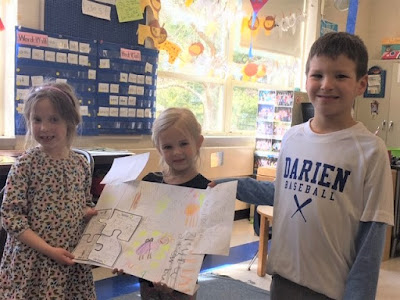We looked for important
vocabulary words while reading our nonfiction texts in Reading Workshop this week. We read through the books and tried to find which words were most important ("expert words"). Sometimes these words are in bold, but most often they are not. Once we found a word, we wrote it on a post-it and stuck it to the book cover. Then when partner time began, we became teachers, teaching new vocabulary to one another and reading new words in texts together.
We continued writing our All About books in Writing Workshop this week. This week we looked at how parts (chapters) of nonfiction texts are organized with a heading on the top. We thought to ourselves "This part of my book is all about...", and we tried to make headings of our own. Once we did this, and wrote more in each part, we had to make sure that the writing we added still connected with the heading, and didn't teach any random facts that didn't belong.
We focused on numerals 20 to 49 this week, building "ten towers", so we could easily count by tens and counting the "extra cubes" leftover to count forward by ones. For example, using place value markers, one would count 43 cubes by first touching the 10 towers and saying "10, 20, 30, 40" and then touching the extra individual cubes and counting forward by ones "41, 42, 43". Some caught on to this quite quickly and it was tough for others. We'll be counting numbers up to 100 this way during this unit, so we'll get more practice. We built numerals using connecting cubes and found the number on a 100s chart and wrote what number comes before/after. (see photo).
We also did a problem solving Exemplar this week. We reviewed how to visualize the problem first, then we solved it with a manipulative model. Next, we made a diagram with a key. Finally, we learned how we can also solve problems with ten frames. Once our diagrams were done, we all used ten frames to show our problem solving.
In our geography lessons, we reviewed positional words (in front, behind, next to, beside, etc) and added in left and right. We played some fun left and right movement games, too. The next day, we learned about a compass rose and how the words north, east, south and west can be helpful when following directions and understanding a map.
News and Notes:

















































